Tanfield Railway
The Tanfield Railway is a 4 ft 8 1⁄2 in (1,435 mm) standard gauge heritage railway in Gateshead and County Durham, England. Running on part of a former colliery wooden waggonway, later a steam railway. It operates preserved industrial steam locomotives. The railway operates a passenger service every Sunday, plus other days, as well as occasional demonstration coal, goods & mixed trains. The line runs 3 miles (4.8 km) between a southern terminus at East Tanfield, Durham, to a northern terminus at Sunniside, Gateshead. Another station, Andrews House, is situated near the Marley Hill engine shed. A halt also serves the historic site of the Causey Arch. The railway claims to be "the world's oldest railway". The Railway is run by three bodies: "Friends of Tanfield Railway", "Tanfield Railway Trust" which owns the railway, the locos & stock and "The Tanfield Railway Company" which operates the railway. "The Tanfield Railway Company" is split into four departments; each has a Manager & Director: Engineering who maintain Locomotives, Operations including drivers & guards, Carriage & Waggon who preserve carriages & the commercial department which operates shops, events & the passenger side of operations.
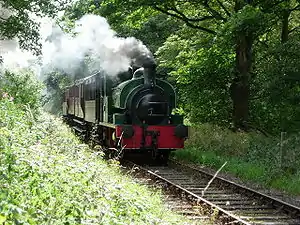 An overview of the railway from Furnace Sidings | |
| Locale | North East England |
| Coordinates | 54.908°N 1.675°W |
| Commercial operations | |
| Name | Tanfield Railway |
| Original gauge | Wooden Waggonway / Iron 4 ft 8 1⁄2 in (1,435 mm) standard gauge |
| Preserved operations | |
| Stations | 4 |
| Length | 3 miles (4.8 km) |
| Preserved gauge | 4 ft 8 1⁄2 in (1,435 mm) standard gauge |
| Tanfield Railway | ||||||||||||||||||||||||||||||||||||||||||||||||||||||||||||
|---|---|---|---|---|---|---|---|---|---|---|---|---|---|---|---|---|---|---|---|---|---|---|---|---|---|---|---|---|---|---|---|---|---|---|---|---|---|---|---|---|---|---|---|---|---|---|---|---|---|---|---|---|---|---|---|---|---|---|---|---|
| ||||||||||||||||||||||||||||||||||||||||||||||||||||||||||||
Colliery Railway
The Tanfield Waggonway was built by the Grand Allies from about 1720 to transport coal more reliably & cheaply from inland collieries of County Durham, to the staiths on the River Tyne at Redheugh. From here the coal was transported in keels downriver to South Shields, then transferred to colliers (bulk coal carrying ships)[1] for the voyage down the North Sea coast to south east England. Many older shorter coal waggonways existed to the north of the present heritage line, in the Whickham & Lobley Hill areas, but the Tanfield Waggonway was a much longer and heavily engineered route which gave the Grand Allies market dominance all year round. (Although supply to SE England was still subject to North Sea winters.) The Tanfield route was in continuous use from 1725 until final closure in 1964.[1]
The route and structures of the oldest section of the now preserved part of the line, between Sunniside and Causey, dates from 1725, and is thus the world's oldest railway still in operation.[1][2] (The Middleton Railway makes an alternative claim to be the oldest railway, as the first railway granted powers under the first railway Act of Parliament in 1758.[2]) The Causey to East Tanfield section was built in 1839.[1]
The Marley Hill engine shed was built by 1854, and was in industrial use until 1970.[1][3] The shed is on the Bowes Railway, whereas locos used on the Tanfield branch were stabled at the nearby Bowes Bridge MPD (a sub-shed of Gateshead), the coaling ramp and turntable pit of which are still visible adjacent to the track between Andrews House and Sunniside. A winding engine occupied the Bowes Bridge site from 1840–81, a locomotive shed from 1881-1962. The headshunt by Marley Hill signal box is the point where the west-east Bowes Railway crossed the south-north Tanfield branch. When the Tanfield Railway began running trains in 1977 a curve was installed to allow Marley Hill locos & trains onto the Tanfield Branch. Marley Hill engine shed is the oldest in the world still used for its original function.[4] As collieries on the NCB line closed in the 1960s, coal was brought by road to adjacent drops for onward rail transport, and the shed saw further use servicing other local colliery locomotives.[4]
Originally a wooden railed horse drawn waggonway, conversion to a steel railed railway began in 1837, and by 1840 was complete as far as Tanfield Moor Colliery, using stationary steam engines, gravity inclines & horses.[3] In 1881, while operated by the North Eastern Railway,[3] steam locomotives replaced the stationary steam engines and horses. Although primarily a coal railway, it did carry some passengers.[3] The railway closed when the last colliery on the line at East Tanfield ceased production in 1964.[3]
Preservation
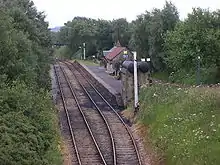
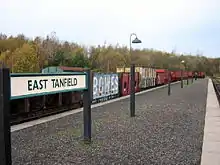
The early years of the railway as a preservation project concentrated on Marley Hill, preparing locos for steaming, working on the shed structure and acquiring basic needs such as water and electricity. Locomotives No.21 (Robert Stephenson and Hawthorns engine of 1954 0-4-0st) and No.5 (Malleable) were steamed in public in 1973. The first passenger train ran for a week August 1975, using locomotives No.21, No.32 and Sir Cecil A Cochrane, and a small carriage acquired from the British Steel Corporation site at Teesside.[3]
The preserved line was first built from Marley Hill to the current northern terminus, Sunniside Station, with passenger trains beginning on 2 July 1981,[3] and an official opening ceremony on 14 July 1982. Andrews House station just south of Marley Hill sheds was completed between 1987 and 1989[3] and was equipped with platforms, a water tower, a station building and a footbridge. The first train south to Causey was on 27 July 1991, with the official opening ceremony being held on 15 August 1991. The first train further south to the current end of the line at East Tanfield occurred on 18 October 1992.[3] East Tanfield Station itself was opened in 1997. The Causey to Tanfield section is through a wood lined gorge.[4]
Part of the reason the line was preserved was the fact Marley Hill shed remained open until 1970.[4] The vintage machinery in the workshop is still capable of full locomotive overhauls.[4] The oldest locomotive on the railway was built in Gateshead in 1873, and all of the railway's carriage stock dates from the 19th Century.[4]
Causey Arch
The current preserved line passes near to Causey Arch, the oldest surviving railway bridge in the world.[4] It was built to carry a new branch from the route of the now preserved line, to a site known as Dawson's Drift.[3] Built between 1725 and 1727, at 150 ft long (46 m) and 80 ft high (24 m), it was the largest single-span bridge in Britain, and remained so for 30 years.[3][4]
Locations
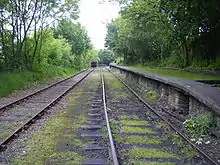
- Sunniside Station 54.920°N 1.675°W
- Marley Hill Signal Box 54.910°N 1.676°W
- Marley Hill Yard 54.910°N 1.677°W
- Andrews House Station 54.908°N 1.675°W
- Causey Arch Station 54.897°N 1.686°W
- (for Causey Arch) 54.897°N 1.688°W)
- East Tanfield Station 54.888°N 1.699°W
Steam locomotives
As of 2017, the Railway has become the home to a large collection of industrial steam engines, with 28 in all, though only three are operational. One is undergoing repairs and three more are under overhaul for future operation, with the other 21 around the Marley Hill site.
Operational steam locomotives
| Number & Name | Description | Status | Livery | Owner(s) | Date | Photograph |
|---|---|---|---|---|---|---|
| Hawthorn Leslie and Company 0-4-0ST, No.2. | Built by Hawthorn Leslie and Company in 1911. Re-entered service after an overhaul in 2013. | Operational | A few different shades of green with lining | Tanfield Railway Trust | 1911 | 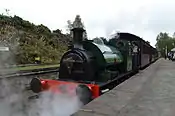 |
| 0-4-0ST Sir Cecil A Cochrane | Sir Cecil A Cochrane was built by Robert Stephenson and Hawthorns in 1948 and worked a few miles from its current home. It is currently in regular use on passenger services and may occasionally be seen hauling a shortened coal train. It has recently undergone a 10-year overhaul. | Operational | RSH works livery (lined green) | Private | 1948 |  |
| 0-6-0T Twizell | Twizell was built by Robert Stephenson and Company in 1891. Currently owned by Beamish Museum, it is currently on long term loan to the Railway as it is too big for Beamish's line. After a 15-year overhaul, Twizzel returned to service in 2010. | Awaiting Repairs | Black, Lined in Red | Beamish Museum | 1891 |  |
| Robert Stephenson and Hawthorns 0-6-0ST NCB No. 49 | Built by RSH in 1943. Passed its steam test on 27 March 2018 thus giving it a new 10 year boiler ticket which expires on 27 March 2028. The locomotive returned to service hauling passenger trains in July. | Operational. | Green with white and black lining | Private | 1943 | 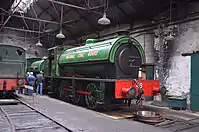 |
Steam locomotives Under Overhaul/Restoration
| Number & Name | Description | Status | Livery | Owner(s) | Date | Photograph |
|---|---|---|---|---|---|---|
| Black, Hawthorn & Co 0-4-0ST, Wellington | The oldest locomotive on the railway. Moved to a contractor in Leeming Bar in September 2019 for overhaul to working order | Undergoing overhaul | Green with Lining | Private | 1873 | |
| Andrew Barclay 0-6-0ST No. 1015 "Horden" | This engine was built by Andrew Barclay. The locomotive has been under restoration since August 2012 and is expected to enter service in early 2021. The boiler returned from an external contractor in mid-May 2019. | Waiting to enter service from early 2021. | N/A | Private | 1904 | |
| Hudswell Clarke 0-6-0ST Renishaw Ironworks No.6 | Renishaw Ironworks No.6 was built by Hudswell Clarke in Leeds in 1919. | Undergoing Overhaul | Green with lining | Private | 1919 |  |
| Hudswell Clarke 0-6-0T No. 38 | Built by Hudswell Clarke in 1949. Undergoing restoration in Marley Hill yard. | Undergoing Restoration | N/A | Rising Sun locomotive Trust | 1949 | |
- Stored steam locomotives
| Number & Name | Description | Status | Livery | Owner(s) | Date | Photograph |
|---|---|---|---|---|---|---|
| Robert Stephenson and Hawthorns No.38 0-6-0ST | 38 was built by Robert Stephenson and Hawthorns in 1954, it is currently stored, in a partially dismantled state, and is in line to receive a cosmetic overhaul. It was one of a number of Identical locomotives which went to collieries in Northumberland, and its generator and electric lights are a legacy of its duties on the Ashington system, where they were necessary for night-time shunting in the yards at Ellington and Lynemouth. | Stored | Black, lined in red | Private | 1954 | 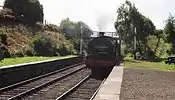 |
| Hawthorn Leslie 0-6-0ST Stagshaw | Stagshaw was built by Hawthorn Leslie as an example of a Cristiani compressed steam system locomotive, however when this was unsuccessful, Stagshaw was converted to a conventional steam locomotive in 1927 and is currently stored at the Tanfield Railway. | Stored | Black | Private | 1923 |  |
| Borrows of St Helens No.3 0-4-0WT | This engine is stored on site at Marley Hill | Stored | 1898 | |||
| Hawthorn Leslie "Cyclops" 0-4-0ST | This engine is now stored at the Marley Hill Site | Stored | 1907 | |||
| Hudswell Clarke 0-4-0ST, Irwell | This engine is stored in large pieces around the Marley Hill site and is a possible candidate for overhaul | Stored | Green with Lining | Private | 1937 | |
| Robert Stephenson and Hawthorns 0-4-0ST, No.21 | This engine is stored undercover and a possible candidate for overhaul. Formerly owned by the CEGB for shunting coal at the Stella power stations | Stored | Green with red and black lining | Private | 1954 |  |
| Sentinel 0-4-0T No.4 | This engine is stored outside on the Marley Hill site and is a possible candidate for overhaul. It is a sentinel shunter and therefore resembles a diesel shunter, yet is a steam engine. | Stored | Red | Private | 1953 |
|
| W.G. Bagnall 0-6-0ST, Gamma | This engine is stored undercover in Marley Hill Engine Shed and can be seen whenever the site is open. | Stored | Originally War Department Black, later NCB Blue with Wasp Striped buffer beams. | Private | 1945 | |
| Robert Stephenson and Hawthorns Hendon 0-4-0TC | One of the four surviving crane tanks from Doxford's Shipyard in Sunderland. This engine is currently stored | Stored | Dark Blue | 1940 | ||
| Andrew Barclay No.17 0-6-0T | This engine is currently stored | Stored | 1913 | |||
| Hawthorn Leslie No.13 0-4-0ST | CEGB loco from Dunston Power Station. This engine is currently stored | Stored | 1928 | |||
| Andrew Barclay "32" 0-4-0ST | This engine is currently being overhauled off site and is hoped to return to the railway within a few years time. | Under overhaul | Private | 1920 | ||
| Andrew Barclay No.6 0-4-2ST | This engine is currently stored | Stored | 1910 | |||
| Robert Stephenson and Hawthorns No.62 0-6-0ST | This engine is currently stored | Stored | ||||
| Robert Stephenson and Hawthorns No.44 0-6-0ST | A former stable-mate of No. 49 at Backworth Colliery. This Engine was built to a similar design as Nos. 16 and 38, but slightly smaller. It is currently stored in Marley Hill yard minus its saddletank and the top half of its cab | Stored | Blue | 1953 | 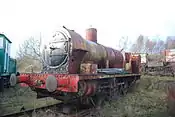 | |
| Robert Stephenson and Hawthorns No.47 0-6-0ST | This engine is currently stored | Stored | 1954 |
| ||
| Robert Stephenson and Hawthorns No.16 0-6-0ST | Another loco from the Backworth Colliery system. Built to the same design as No. 38, although minus the generator and electric lights. This engine is currently stored | Stored | Dark Blue | 1957 |
| |
| Hawthorn Leslie No.3 0-6-0ST | This engine is currently stored | Stored | ||||
| Hawthorn Leslie Huncoat No.3 0-6-0F | This fireless locomotive is currently stored | Stored | 1884 | R and W Hawthorn "Enterprise" 0-4-0ST | ||
Diesel and electric locomotives
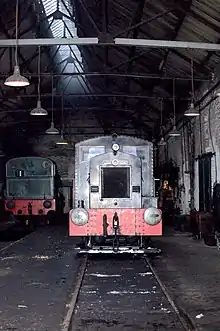
Information from the Industrial Railway Society:[5]
- AEG Bo-BoWE no. 1565 / NCB No.9
- Armstrong Whitworth 0-4-0DE no. D22/1933
- Robert Stephenson and Hawthorns 0-6-0DM no. 7697/1953
- Robert Stephenson and Hawthorns 0-4-0DM no. 6980/1940
- Robert Stephenson and Hawthorns 0-6-0DM no. 7746/1954
- Robert Stephenson and Hawthorns 0-4-0DM no. 7901/1958
- Robert Stephenson and Hawthorns Bo-BoWE no. 70··78/1944
- Andrew Barclay 0-6-0 615/1977 on hire to the Aln Valley Railway
- English Electric and Baguley 3565/1960
- Key
- DE = diesel-electric
- DH = diesel-hydraulic
- DM = diesel-mechanical
- WE = overhead wire electric
Coaching Stock
All of the railways coaches are wooden bodied, Victorian coaches.
- TR No.1 Open Balcony Coach ex GWR Van
- TR No.2 Open Balcony Coach ex GWR van
- TR No.3 Open Coach with Guards Van eX LNER Ballast brake van
- TR No.4 Open Coach with Guards Van ex LNER Ballast brake van
- TR No.5 Compartment Coach. Originally a GNR Coach
- TR No.6 Open Buffet Coach. Originally a GNR Compartment Coach
- TR No.7 Open Poppleton Coach with Guards Van. Originally an NER Director's Saloon
- TR No.8 Compartment Coach with Guards Van. Originally an MS&L Brake Van
- NER No.256 Compartment Coach built 1878
- NER No.818 Compartment Coach
- NER No.A15 Compartment bogie carriage
The Railway also has other unrestored coaching stock.
Additional photographs
 Marley Hill yard
Marley Hill yard Locomotive Stagshaw
Locomotive Stagshaw Diesel works train passing Marley Signal box on the running line. A headshunt from Marley Yard crossed the line here for a few yards before it was lifted in 2012.
Diesel works train passing Marley Signal box on the running line. A headshunt from Marley Yard crossed the line here for a few yards before it was lifted in 2012.
References
- "Tanfield Railway". Wear > Places > Places features > Tanfield Railway. BBC. 21 May 2008. Retrieved 4 July 2009.
- Dewell, Mark (4 August 2000). "Alternative Attractions in NE England". Tywyn, Gwynedd: Heritage Railway Association. Archived from the original on 20 October 2008. Retrieved 4 July 2009.
- Grant, John; Darroch, Nathan (13 December 2008). "The Tanfield Railway". Railways of Britain (http://railways-of-britain.com). Retrieved 4 July 2009.
- Best of Britain's Steam Railways. AA Publishing. 2006. ISBN 0-7495-4212-8.
- Industrial Locomotives: including preserved and minor railway locomotives. 15EL. Melton Mowbray: Industrial Railway Society. 2009. ISBN 978-1-901556-53-7.
Further reading
- The Tanfield Railway (Causey Extension) Light Railway Order 1991
- History of the Tanfield Wagonway Sunniside Local History Society
External links
| Wikimedia Commons has media related to Tanfield Railway. |


